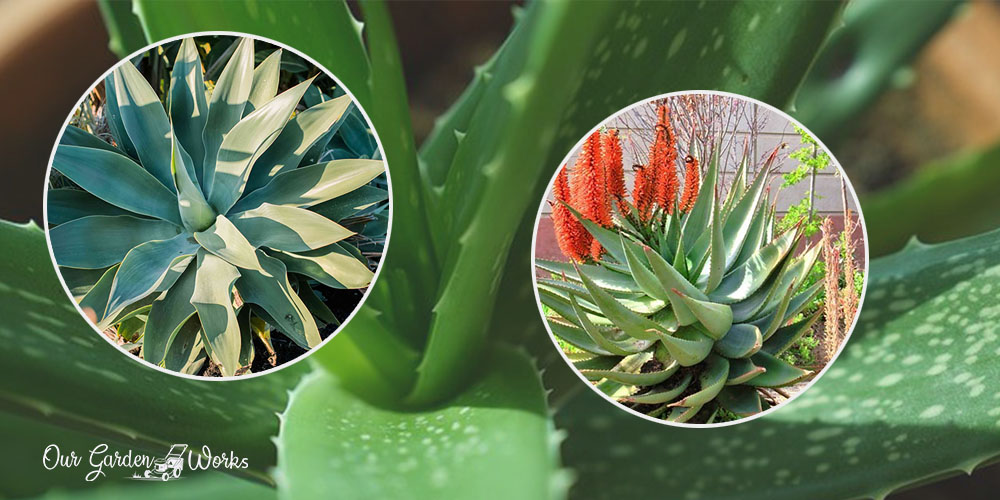The aloe vera found in skincare products, drinks, and sunburn soothing gels have look alikes that can dupe you at a glance.
Plants that look like aloe vera have the same rosette formation of fleshy leaves, spikes, and white spots. However, some of them are poisonous and should be kept away from curious children and pets.
Aloe vera is priced for its gel that has medicinal and hydrating effects on the skin. It is only one of the 600 species of the aloe genus. Members of the aloe grow in arid soil environments and tropical climates. They are grown as perennial in non-tropical areas.
Since most of us only know about aloe vera, allow us to introduce you to other varieties of aloe that thrives mostly in South Africa, Madagascar, and Yemen.
Contrary to the low-growing rosette plant that we know, some aloe varieties can grow into a full-grown tree.
- Aloe aculeata or red hot poker aloe.
- Aloe albida.
- Aloe albiflora.
- Aloe arenicola.
- Aloe argenti cauda.
- Aloe bakeri.
- Aloe brevifolia.
- Aloe broomii.
- Aloe camperi.
- Aloe capitata.
- Aloe comosa.
- Aloe corallina.
- Aloe dewinteri.
- Aloe erinacea.
- Aloe ferox.
- Aloe helenae.
- Aloe hereroensis.
- Aloe inermis.
- Aloe jucunda.
- Aloe jawiyon.
- Aloe khamiesensis.
- Aloe kilifiensis.
- Aloe maculata.
- Aloe barbadensis.
- Aloe nyeriensis
Why it’s important to identify aloe vera among its lookalikes
Some plants that look like aloe vera contain calcium oxalates which makes them poisonous for human and animal consumption and topical use.
Calcium oxalates are microscopic crystals that has a sword-like shape that can create tiny punctures on the soft tissues of our mouth, throat, and skin.
When plants with calcium oxalates are ingested, they cause a burning sensation from the mouth as it slowly goes to the throat and stomach.
If applied on skin, it may cause skin allergies or rashes in some people. In worst cases, the crystals in the digestive tract can lead to kidney failure and other life-threatening conditions.
Calcium oxalates are the substance that is found in most toxic plants for pets like true lilies. Therefore, careful identification of a plant before using them or even planting in your garden can be a life-saving step that your future self will thank you for.
10 Plants That Look Like Aloe Vera [Other plants & Aloe Varieties]
Some aloe varieties have uncanny resemblance to aloe vera that can certainly make you think they’re the same.
So, we included them in this post along with other plant species that share the same rosette and fleshy leaves features as aloe vera.
Aloe varieties similar to aloe vera
Here are some aloe varieties that may be mistaken as aloe vera due to their growing habit, leaves, and other features:
#1 Aloe argenticauda
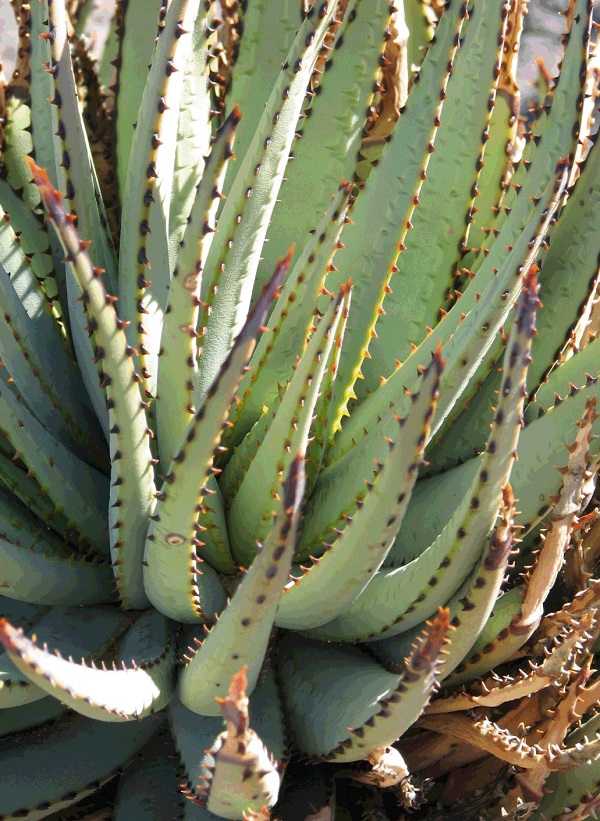
With its fleshy leaves and rosette formation, you will suspect that Aloe argenticauda is an aloe vera.
It is an aloe variety that is endemic in Namibia and often found in the desert. In other parts of the world, it thrives in tropical and subtropical regions.
The only distinction of aloe argenticauda is its toothed leaf edges with dark spikes.
Like aloe vera, it is low-growing and spreads in the ground in clumps. Without a closer look, anyone can easily assume its resemblance to aloe vera.
#2 Aloe brevifolia or short-leaf aloe
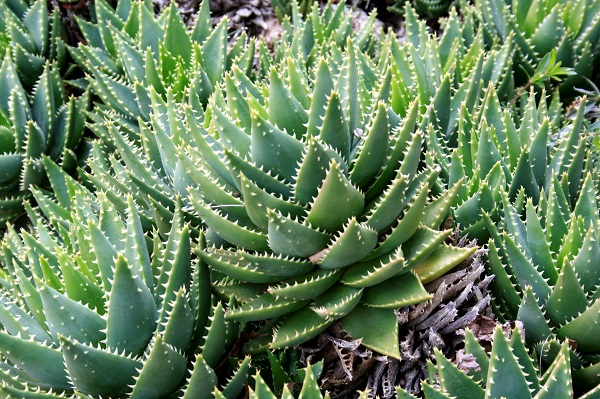
Short-leaf aloe will definitely deceive your eyes since it is like a miniature aloe vera.
It has short foliage arranged in a rosette pattern. It is an evergreen that spreads in the ground like a carpet of rosettes. Compared to aloe vera, it has more triangular fleshy leaves.
What makes short-leaf special is its leaves change in color based on the light that it receives.
The fleshy leaves turn pale blue in partial shade and rosy pink or golden yellow when exposed to full sun. Its toothed edges are more prominent due to its short white spikes that are closely placed at the edges.
Mini aloe vera or aloe brevifolia develops spikes that hold its tubular blooms. Each spike can grow up to 1 to 2 feet.
Due to its small size, a lot of people consider this tiny plant as an ideal houseplant or a part of a succulent collection indoors.
#3 Aloe Campari
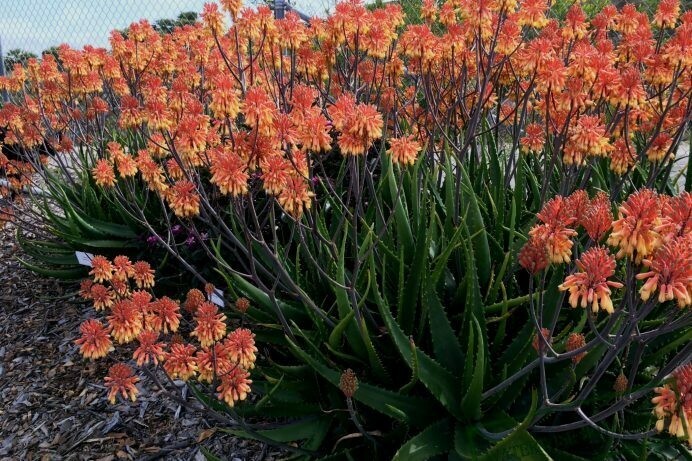
Aloe camperi is an aloe variety that will surely pique your interest due to its unique sets of blooms.
Known as popcorn aloe, aloe camperi possess the same rosette growing pattern as other aloe varieties. It has fleshy leaves with toothed edges filled with soft spikes.
Many gardeners love aloe camperi because of its blooms that grow from the plant’s tall stems. The blooms have a bright apricot color that can stand out in any garden.
With its blooms, nobody would suspect that under its branched stems lies the fleshy foliage of this aloe variety.
The aloe camperi blooms are less tubular which is typical to aloe varieties. Its long stems that reach around 1.5 feet is also one of its distinct features.
Overall, the plant with its blooms and long stems can reach up to 3 feet. Most aloe varieties bloom in winter, but aloe camperi blooms can last longer until the early weeks of spring.
#4 Aloe maculata or soap aloe
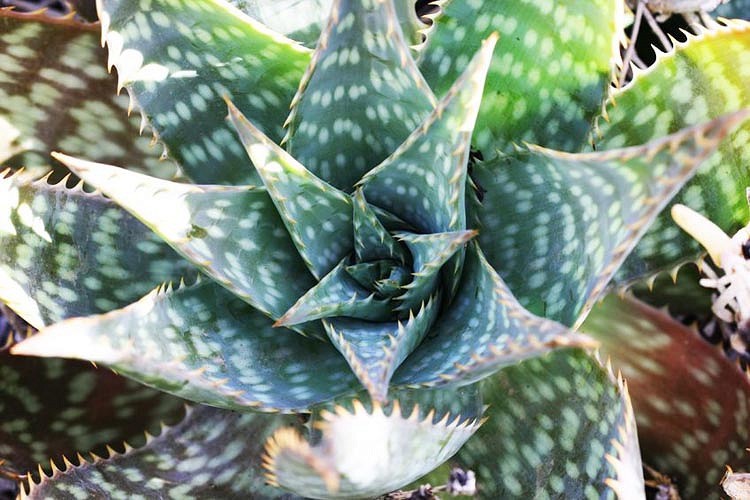
If aloe vera is used for skin care, soap aloe or aloe maculata is a good substitute for traditional soap.
Also known as zebra aloe, soap aloe is one of the plants that look like aloe vera because of its fleshy leaves and rosette growth habit. However, the leaves are more sword-shaped than a typical aloe.
The distinct feature of soap aloe is its sap that can be used as soap and its fleshy leaves that turn pinkish in full sun and bluish green in shade.
You may recognize it immediately because of its prominent white spots on the leaves. From winter to spring, it displays coral-colored blooms that help attract pollinators like hummingbirds and bees.
#5 Aloe ferox or bitter aloe
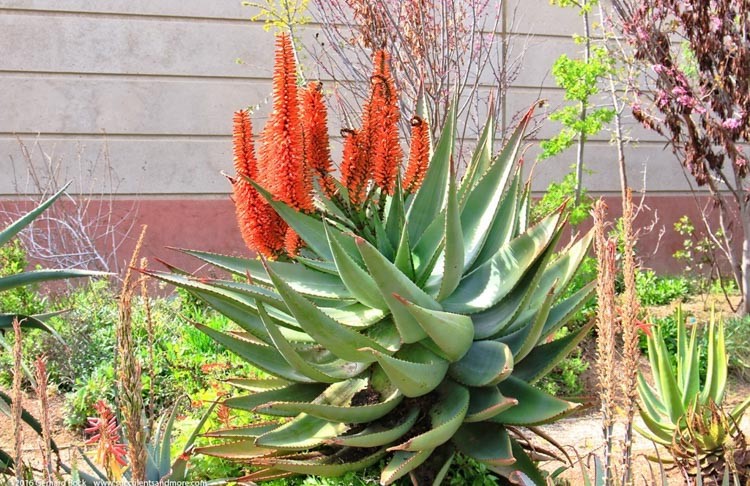
Aloe ferox is an unusual kind of aloe since it is a woody aloe that has a trunk that grows underneath its rosette crown.
The gel in its fleshy leaves can be used as an alternative to aloe vera gel due to its medicinal and skin-nourishing benefits.
In Africa, it is used as a purgative medication and an essential ingredient in cosmetic products.
Among all the plants that look like aloe vera, aloe ferox is among the few varieties that are sourced for its gel. However, patients who consume it as medicine must endure its bitter taste.
Other plants that look like aloe vera
Moving on from aloe varieties, here are other types of plants that look like aloe vera from its leaves to its rosette patterns.
#1 Agave
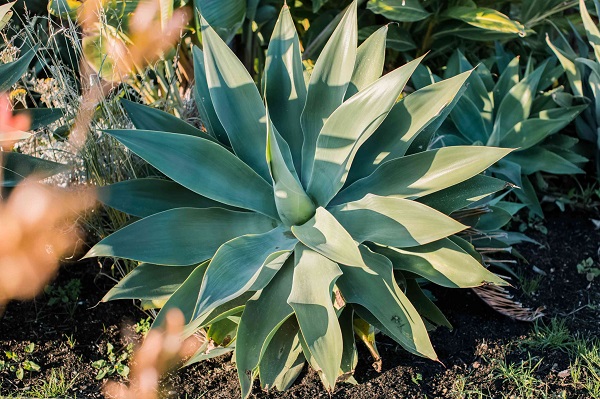
With its rosette pattern, fleshy leaves and bluish green color, you might consider agave as aloe vera.
However, it is a genus of desert plants that has 200 species. Like other succulents and aloe varieties, it is a native to arid and extremely dry areas mostly found in America, Mexico, and the Caribbean.
Different varieties of agave are known as a source of alcohol, sugary syrup, and fiber for making ropes.
Unlike edible aloe vera varieties, its flesh is toxic and filled with calcium oxalates. Therefore, products derived from agave are processed first before the production.
Here are some of the popular agave varieties known for the products they produce:
- Blue agave: used for tequila and mezcal.
- Sisal: source of fiber that can be used to make ropes.
- Henequin: contains fibers that can be used as biofuel.
- Century plant, maguey, and blue agave: best sources of agave nectar or syrup.
- Agave americana: used for landscape.
Different varieties of agave can grow from 12-18 inches to 10-12 feet high. A good indicator of its identity is its height and toothless leaf edges.
They usually bloom once every 10 to 20 years. So, gardeners usually anticipate their blooms and appreciate their asparagus-like stems.
Some of the Ideal varieties of agave for home growing are as follows
- Foxtail (A. attenuata).
- Caribbean (A. Angutifolio).
- Blue (A. tequilana).
- Whale’s tongue agave (A. Ovatifalia).
#2 Haworthia
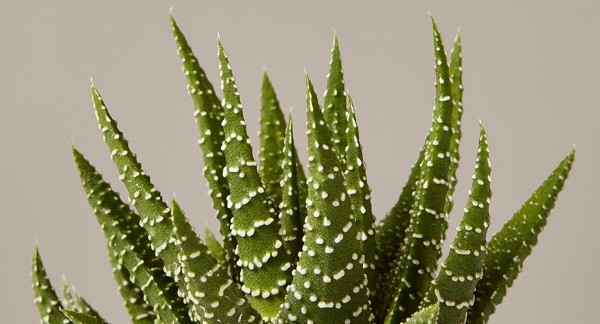
From the leaf shape to its rosette growth, haworthia is probably one of the top plants that look like aloe vera. It is a member of subfamily Asphatuloidaea that resembles the mini or dwarf varieties of aloe vera except its flowers.
Haworthia is a genus of its own and a native plant in South Africa. Its distinct feature that sets it apart from aloe vera is its pearly warts found on the leaf surface. It is a low-growing plant reaching up to 3 to 5 inches high.
A lot of succulent collectors love haworthia for its aloe-like features but also its versatility to grow indoors and outdoors. It is non toxic to pets and considered as an edible in some countries.
#3 Gasteria

If looks can be deceiving, gasteria is another tricky one. This aloe-looking plant is actually a rare genus of its own.
Its common name is ox tongue because of its long fleshy round-edged leaves with rough texture. Its low-growing nature and spotted leaves are the features that make it look so similar to aloe vera.
Like aloe varieties, haworthia produce tubular red and pink flowers in spring and winter. It has 20 species that can grow from 4 to 24 inches high. Unlike a typical aloe, it is also spineless which is a good hint for its identity.
#4 Dryland bromeliads
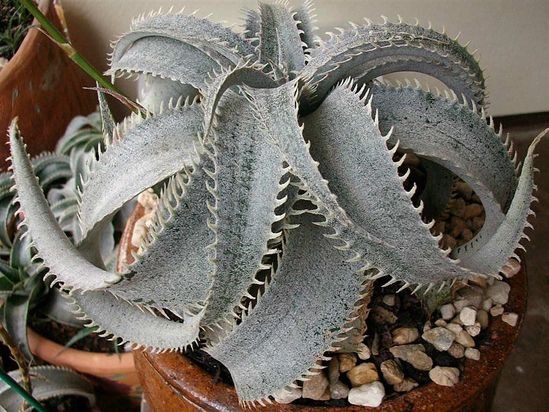
Bromeliads are known for their unique blooms and cups that naturally become a catch basin for rainwater. However, its variety called dryland bromeliad has a unique resemblance to aloe vera for its fleshy leaves with spiked edges.
Dryland bromeliad is an octopus-looking genus of family bromeliadiaceae. It has its own character for having stiff spikes on its waxy foliage. It is not considered as a succulent since it can’t store water in its leaves. It prefers arid growing environments that are rocky and dry.
Members of the genus dryland bromeliads can have foliage that are long, strappy, and thorny or short and scalloped. They bloom in spring displaying red, yellow, and orange blooms in the garden.
Unlike a typical bromeliad, this dryland bromeliad can only grow up to 6 to 12 inches. It is also pretty versatile and can withstand occasional rainfalls and thrives in sunny climate for the rest of the year.
#5 Bergeranthus
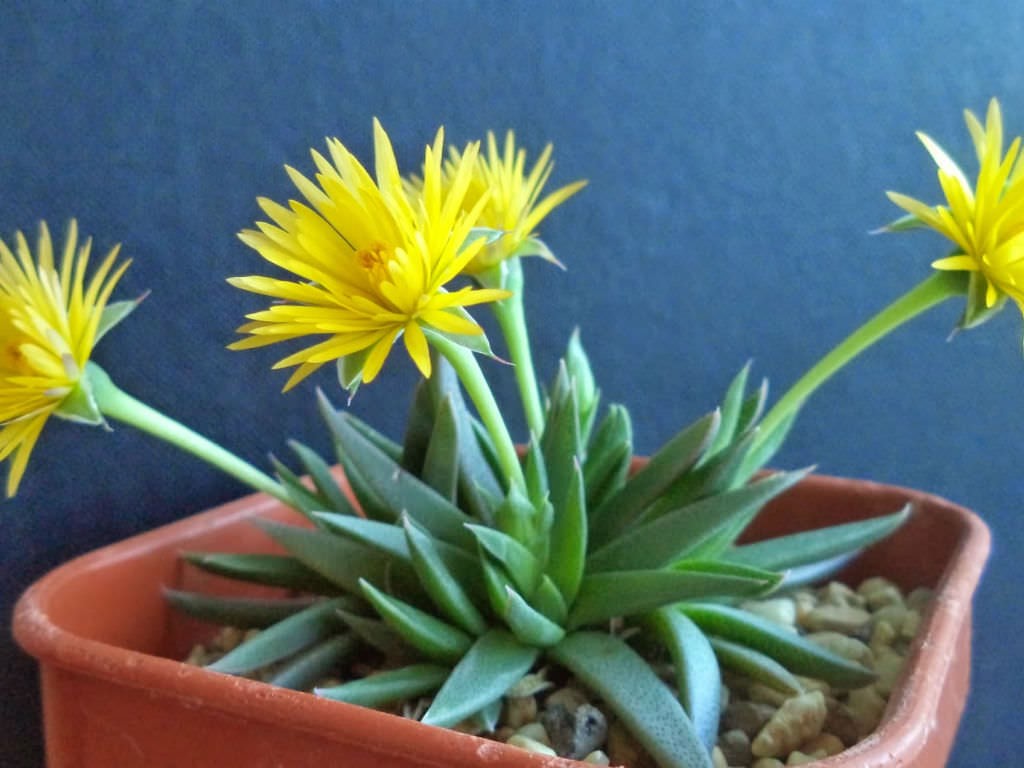
Probably the smallest aloe vera look-alike in this list goes to Bergeranthus. It is a genus of dwarf succulents from the family Alzoaceae.
It is a very small plant that looks like a mini aloe without its spots and horned leaf edges. Though it has fleshy leaves, the edges and surface are more rounded which gives away its identity as a plant.
Bergeranthus is a low-growing plant loved by succulent growers for its easy growing nature and for being low-maintenance. Due to its size, it’s a perfect houseplant like haworthia. Additionally, it develops vibrant yellow blooms.
Aloe vera lookalikes that are poisonous
Plants have a way of tricking gardeners due to their similar features. While these similarities make them more appealing to a green thumb, it can be dangerous if they are mistakenly used as a medicine or a skincare ingredient.
To protect yourself from plant poisoning and other toxic aloe varieties, here are the poisonous varieties that you should be aware of:
- Aloe Ballyi.
- Aloe Elata.
- Aloe Ruspoliana.
- Aloe Africana.
- Aloe Striata.
- Aloe Polyphylla.
- Aloe variegata.
- Aloe Aculeata.
- Aloe Chabaudi.
- Aloe Cryptopoda.
- Aloe Gradidentata.
- Aloe humilis.
- Aloe khomeini.
- Aloe lineata.
- Aloe Sopanar.
Final Thoughts
We hope that this post helped you discover the plants that look like aloe vera and get you familiarized with their botanical and common names.
Knowing these new plants can help broaden your knowledge in gardening and make you more aware of the vast multitude of plants on this planet.
Let us know in the comments which aloe look-alike piqued your interest! Also, please don’t forget to share this post to your friends and save them from buying the wrong plant, thinking it is aloe vera.
